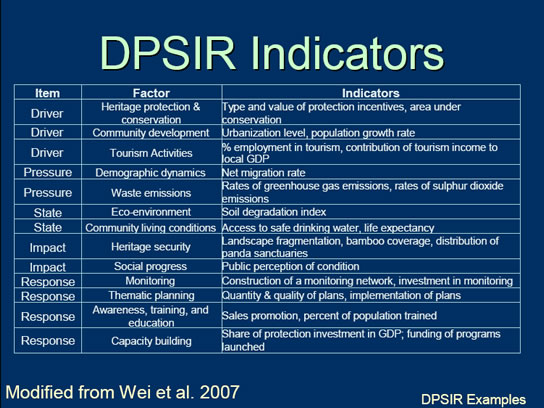Tutorials on Systems Thinking
DPSIR Indicators

12 / 19
The authors used the DPSIR framework to generate a tentative list of sustainable development indicators which could be used to monitor management activities.
In addition to natural physical drivers, including climate change, key socio-economic Drivers and their corresponding indicators, included:
- Heritage protection & conservation: type and value of protection incentives, area under conservation
- Community development: urbanization level, population growth rate
- Tourism Activities: % employment in tourism, contribution of tourism income to local GDP
These Socio-economic drivers create Pressures, and their corresponding indicators, on the state of the ecosystem through
- Demographic dynamics: net migration rate
- Waste emissions: rates of greenhouse gas emissions, rates of sulphur dioxide emissions
Changes in the State that can be monitored include
- Eco-environment: Soil degredation index
- Community living conditions: Access to safe drinking water, life expectancy
Changes in the ecological and environmental state can have Impacts on indicators of
- Heritage security: landscape fragmentation, bamboo coverage, distribution of panda sanctuaries
- Social progress: public perception of condition
Long-range management actions, or Response, may be quantified by
- Monitoring: construction of a monitoring network, investment in monitoring
- Thematic planning: quantity & quality of plans, implementation of plans
- Awareness, training, and education: Sales promotion, Percent of population trained
- Capacity building: share of protection and pollution treatment investment in GDP; funding of programs launched
Wei, J., Z. Yountao, X. Houqin, and Y. Hui. 2007. A framework for selecting indicators to assess the sustainable development of the natural heritage site. Journal of Mountain Science 4:321-330
